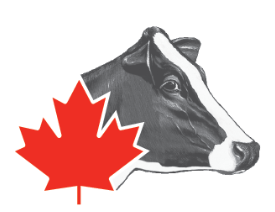
Source: Holstein Canada
Tight margins, increasing heifer rearing costs, and low dairy sale prices are a very real reality in today’s dairy industry. In this scenario, increasing profitability of the operation is essential. Some aspects to achieve that are high production (milk & fat), higher milk income over feed costs, lower heifer raising costs, and longer-lasting cows. What can producers do to improve them all? Enhance reproductive performance!
Lactanet records that reproduction is the main reason for culling in Canada, accounting for almost 21% of all culling and 25% of non-dairy sale culling. The chance of a cow being involuntarily culled – when she leaves because of some factor that impairs her performance – increases drastically after she reaches 200 days in milk (DIM). As her lactation continues to climb in DIM, the reality of culling only becomes closer. Most of this increase in culling results in lower profitability; a pregnancy after 250 DIM can rarely be economically justified, unless the cow is a great producer and has higher genetic merit than her herd-mates. After 90 DIM, each day she remains open costs roughly $4.50/day. By 250 DIM, the economic loss is $720-$1000.

You can play with the lactation curve!
The normal lactation curve is very well defined: a cow starts increasing her production until peaking at 60-90 DIM. From then on, the production keeps decreasing over time, until dry off before next calving. With that information, how can you optimize production and income over feed cost? Keeping your cows closer to peak lactation! Shifting your average DIM closer to peak DIM will likely do the trick. Easier said than done, but let’s dive into it.

A high average DIM herd has reducing return over feed cost, and the path to reduce it is by getting cows pregnant earlier in lactation. By doing that, the herd DIM will be closer to peak DIM, resulting in higher production. Basically, it is a scenario with less cows with high DIM, after DIM earlier lactation and more productive ones. In general, the economic value of an open cow decreases drastically as the lactation gets longer and there are two ways to increase her value: 1) increasing production or 2) becoming pregnant. A 10% production increase results in over $500 more economic value for a cow open at 120 DIM, while a pregnancy at the same 120 DIM increases the value by $200, avoiding further decrease in value as the days go by. The decision on how early your cows should get pregnant comes down to a few points: maintain a herd of higher production and persistent lactation – achieved by sound genetics and strong management, or ensure your cows are getting bred (and pregnant) early and herd’s days open do not go over 120 DIM.
More milk + more longevity = profit!
Aiming for earlier pregnancies can strongly reduce the risk of culling, as cows have more opportunity to be safe in calf before later stages of lactation. Again, the higher the DIM, the more likelihood a cow won’t be paying her bills. Reducing involuntary culling is determinant for more profitability, and two national averages show that producers should emphasize longevity: the break-even number of lactations and average number of lactations per cow. The first means how many lactations an average cow must have to pay back her raising costs, which right now sits around 1.4 lactation in Canada. Considering the average number of lactations per cow in Canada is 2.2, each cow “profits” for just 0.8 lactations on average.

In a simple way, getting more cows that last three or more lactations means more money in your pocket. A US study showed that optimal lifespan for profitability is five lactations*; even though the reality of the Canadian industry is different, it is clear that increasing longevity is determinant for better return over investment. One challenge that can come up with more long-lasting cows is an excess of replacements. To counter that, it is crucial to invest (raise) and keep just the best ones. A few strategies could be adopted to reduce the amount of young stock and optimize herd turnover. Selling more lower end lactating cows and poorer genetic heifers is an alternative to make more room for heifers with higher genetic potential, while keeping higher end (and more profitable) cows. Also, using sexed semen more selectively (just on top end animals), and breeding bottom end cows and heifers to beef semen are both possibilities to reduce the number of heifers in the barn. Holstein Canada provides several tools that help identify the best animals and manage the genetic progress in your herd, such as genotype testing, classification and Compass.
Takeaways
Fertility has a tremendous impact on farm profitability, largely tied to milk production and culling. The economic gain of a 1% increase in pregnancy rate can be up to $20/cow/year, depending on the herd average rate. Making sure your cows are getting pregnant early reduces the herd average DIM, increases production and reduces the risk of culling. By doing that, it is possible to be more selective and keep just the best and more profitable animals. In addition, there are other aspects such as genetics, heifer rearing, and mating strategy that help optimize your herd’s potential. To learn more about these topics, look for Part Two of this series in the next InfoHolstein edition!
*De Vries, A., 2020. Symposium review: Why revisit dairy cattle productive lifespan? Journal of Dairy Science, available at https://www.journalofdairyscience.org/article/S0022-0302(20)30120-X/pdf







